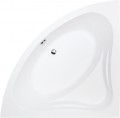Shape
The shape of the bathtub along the upper outer edge. This determines both the appearance and the installation features, and in many cases, also the use. Note that the outlines of the interior space (where the water is directly poured) often do not match the declared shape - for example, rectangular bathtubs usually have an oval interior. This is done to ensure the convenience of the bather.
—
Rectangular. Traditional, the most common form. It is very versatile, equally well suited for installing a bathtub separately from the walls, against a wall or even in a corner. There are also angles that are not strictly straight, but are made with a characteristic rounding. Beveled angles give a feeling of smoothness and harmony. Note that both the contours of the bathtub as a whole and its bowls in particular can have a rounded shape.
—
Rectangular with an arc. Rectangular bathtubs with one of the sides in an arc (curved) shape. Such a design trick can have both aesthetic value and practical advantages. In particular, the arc shape often improves ergonomics, supporting a more comfortable position when taking a bath.
—
Corner versatile. A mandatory feature of any corner bathtub is the presence of two sides converging at a right angle (they are tightly adjacent to the walls of the room when installed). In this case, these sides have different lengths, henc
...e the name. The outer part, not in contact with the angles, can have different shapes, but most often it is made rounded.
— Corner symmetrical. A type of corner bathtub in which the sides adjacent to the corner of the room have the same length. In all other respects, such models are completely analogous to corner symmetrical ones (see above).
— Oval. In oval bathtubs, the shape of the outer edge usually follows the contours of the interior space. The appearance and design of such products can be different — for example, some look like rounded rectangles and can be installed close to the wall, while others are closer to the classic oval (without straight lines) and are designed rather for freestanding placement.
— Round. As in oval (see above), the external and internal shapes in such bathtubs are identical. This shape is convenient for two-seater models; in addition, it is very advantageous — a round bathtub requires less material than an oval or rectangular bathtub of the same volume. However, such products are practically not suitable for installation in a corner.
— Square. For a number of reasons, the square shape is found mainly among two-seater bathtubs, and even then very rarely. The interior space in such products can be either round or oval (elongated diagonally from the square); and the square shape of the outer edge is provided for the convenience of corner installation. Note that such bathtubs take up quite a lot of space.
— Semicircular. Baths in the shape of a half circle are usually designed for installation against a wall, with the flat side against the wall. This option is found mainly in designer models with two seats.
— Barrel-shaped. Baths that resemble a barrel in shape. Typically, such models have curved sides that form a rounded and smooth shape — like a classic barrel. With their outlines, barrel-shaped products create visually pleasing effects and ensure a comfortable fit in the bath.
— Non-standard. This category includes bathtubs that do not belong to any of the above-described shapes. “Non-standard” products are available in a variety of shapes: a rectangle with a curved front, an oval with a panel for corner installation at one end, a polygon, a triangle with rounded angles, etc. This option should be considered primarily by those for whom the original appearance of the bathtub is important along with functionality.Volume
The working volume of the bath is usually indicated by the amount of water that can be poured to the level of overflow.
In general, the larger the volume - the, as a rule, the more comfortable the bath, the higher the likelihood that it will be able to lie down or even dive into the water almost entirely, up to the neck. However, it should be borne in mind that models of the same volume can differ markedly in size and shape (both external and internal). This means that large capacity does not yet guarantee convenience for a particular user. In addition, filling the volume bath will take more time and require more water, which can be critical if there are meters or limited water supply (for example, hot water from the storage boiler).
Wall thickness
Wall thickness indicates not only the thermal conductive properties, but also the durability of the product. However, the same parameter affects the price of the device. Accordingly
thick-walled baths makes no sense to acquire for rare use. It is enough to make do with
5 mm .
Shelf
Built-in
shelf in the tub structure, located above the overflow level. It can be used to put soap and bathing accessories.
Dimensions (LxWxH)
Size of the bath in length, width and height. When choosing, it should be borne in mind that the length and width are specified on the outer dimensions - this allows you to estimate the place required for the installation of the bath, but its internal dimensions are inevitably obtained less. But as a height it is customary to indicate the depth - the distance from the top edge to the bottom. Here we note that the high altitude allows you to dive deeper into the water, but may cause some people (for example, elderly or suffering from leg diseases) problems when entering the bath.

